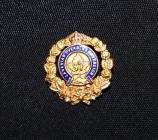28
Framed Portrait of Robert Bell in 43rd Cameron Highlanders Battalion Dress Uniformca. 1916
 Credits:
Credits:Loaned to Greater Sudbury Museums by Robert Pappin
29
Part 1/3: Robert Bell's account of the Somme28 October 1916
The Somme, France
In a letter to his parents published in the Sudbury Star (October 28th, 1916), Robert Bell gives an account of his involvement in the Somme offensive and how he was injured:
"I was only eight days at the Somme from Ypres. I was wounded on the 20th of September and in the hospital on the 23rd, which is pretty quick work. It was a surprise attack and we were pulling it off early in the morning, about five o'clock. Fritz' trench, a strong point, was about two hundred yards from our line. A continual rain for two days had mixed things up a little and we could scarcely get through the mud and water and a kit of 27 pounds, and a rifle made it all the heavier. No. 3 section of the bombers, the one I am in, had to stay in our trenches (shell holes) and Nos. 2 and 4 sections started out to crawl the 200 yards, and we were to run up if the attack failed. Fritz got wise but it was too late and the trench was taken. However, we fellows had to stand the shelling, as he could not shell the front trenches, as he would shell his own men. Our fellows stood their ground in the captured trench, but daylight was upon them before they could send for reinforcements and the runner they sent back was wounded. Poor fellow - he managed to get back under fire - but he was in a terrible state. He told me that our men up in the captured trench had run out of bombs and to hurry back with some..."
Credits:Excerpt from the Sudbury Star, October 28, 1916
30
Epaulettes from R. Bell's Cameron Highlanders Dress UniformWorld War I, 1914-1918
 Credits:
Credits:Loaned to Greater Sudbury Museums by Robert Pappin
31
Part 2/3: Robert Bell's account of the Somme28 October 1916
The Somme, France
Continued:
"I was helping to dig a communicating trench from our line to Fritz's. I dropped my shovel and ran and notified an officer and then the N. C. O.'s in No. 3 section. Our section was hurriedly got together. I grabbed a box of twelve bombs and beat it over the open ground. You would scarcely believe it, but it was an act of Providence, me getting as far as I did, because it was already bright daylight (6:30) and the hail of lead was terrible.
Several times I said to myself, 'I will never get back for a second trip.' I was running double when I came to a shell hole. I jumped in for a second and looked back for the other fellows, but I was all alone. I beat it on again. I had taken only a couple of steps when one bullet went through my steel helmet. It dazed me but there was no scratch. A second after I felt a burning sensation in my shoulder and the power left my arm. I had just about reached the trench, but it was useless for me to go in there wounded, so I left the box within reach and beat it back, waiting for a pink in the back any time..."
Credits:Excerpt from the Sudbury Star, October 28, 1916
32
43rd Battalion C.E.F. Winnipeg, Cameron Highlanders of Canada cap badgeWorld War I, 1914-1918
 Credits:
Credits:Loaned to Greater Sudbury Museums by Robert Pappin
33
Part 3/3: Robert Bell's account of the Somme28 October 1916
Concluded:
"I was feeling feint through loss of blood and was out of wind. I dropped in one of Fritz's shell craters for a rest, but the blood flow was too great to take chances, so I beat it back for the lines. My pal was standing by the first aid dugout, all fixed up, he having been wounded half an hour previous to me. The Red Cross men were so busy that I would have to wait too long to be dressed, so I only had the flow of blood stopped and started for the ambulance with my pal. We had all of three miles to walk under heavy shell fire for Fritz had a fine curtain of fire to stop supports from coming up. But we got through all right."
The newspaper added:
"Pte. Bell says the service given by the Red Cross is great. He adds a note saying that the doctor was just in and told him that he thought he would be able to leave the hospital the same week. It will, however, Pte. Bell says, be a month before he gets back to the front."
Credits:Excerpt from the Sudbury Star, October 28, 1916
34
Shrapnel extracted from R. BellWorld War I, 1914-1918
 Credits:
Credits:Loaned to Greater Sudbury Museums by Robert Pappin and Family
35
Canadian Engineers, C.E.F. cap badgeWorld War I, 1914-1918
 Credits:
Credits:Loaned to Greater Sudbury Museums by Robert Pappin
36
Dumping Slag in Copper CliffWorld War I, 1914-1916
Copper Cliff, Ontario, Canada
 Credits:
Credits:Copper Cliff Museum Collection
37
International Nickel Co. General Officesca. 1918
Copper Cliff, Ontario, Canada
 Credits:
Credits:Copper Cliff Museums Collection
38
General OfficeWorld War I, 1914-1918
Copper Cliff, Ontario, Canada
 Credits:
Credits:Copper Cliff Museum Collection
40
Cochrane Hardware Victory Bond Ad6 November 1918
Copper Cliff, Ontario, Canada
 Credits:
Credits:Greater Sudbury Public Libraries Sudbury Star Microfilm Collection

